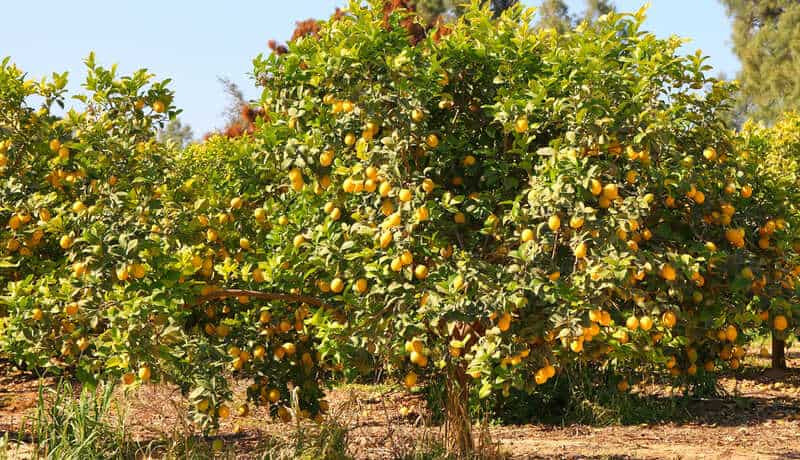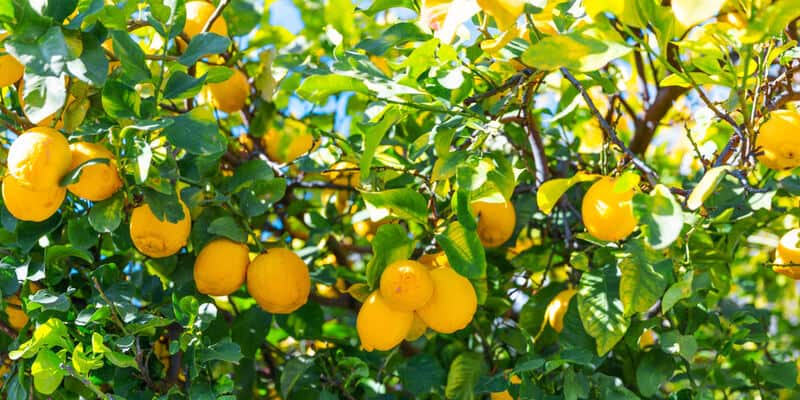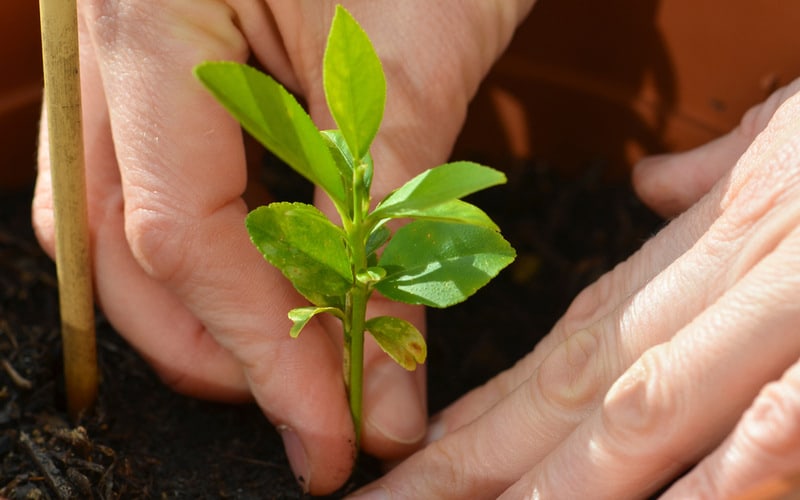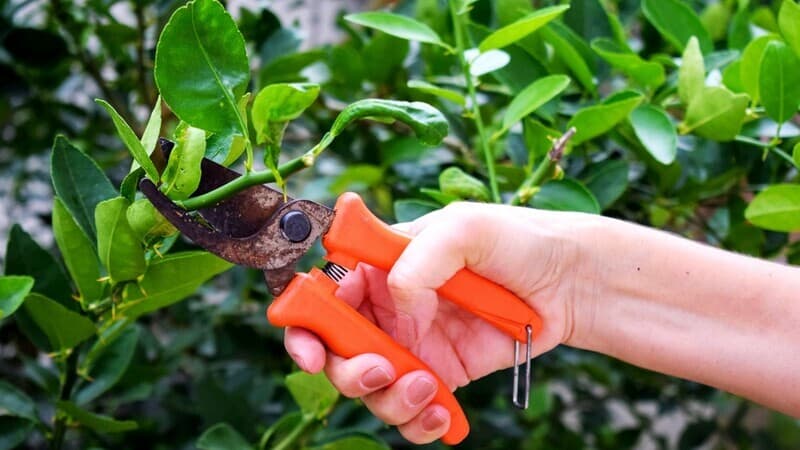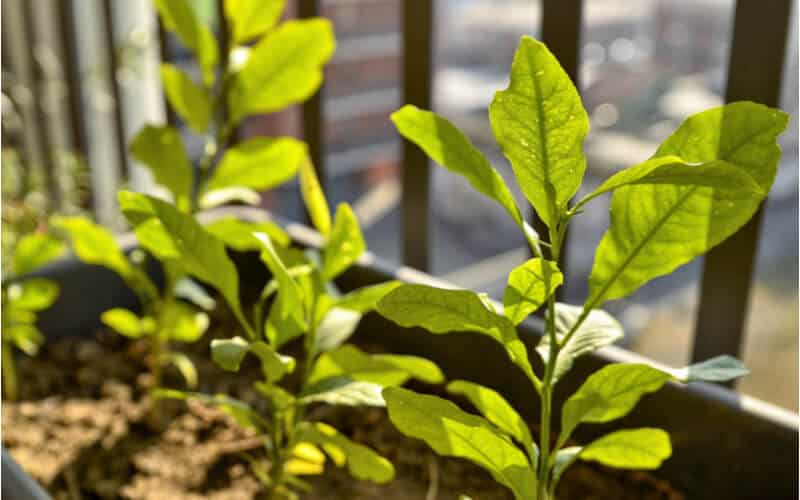No tree hollers sunny happiness more than the lemon tree. Cut open a lemon and you can practically imagine the smiley emoji jumping out from the fruit. Forget the ubiquitous lemonade, you can do so much more with this citrus plant!
Brighten up salt, pepper, and olive oil by infusing them with lemon zest. Looking to unwind? Add a fresh twist to your ice-cold beer or favourite cocktail by garnishing it with a lemon wedge. When cooking, a little lemon juice will go a long way to elevate ordinary chicken, salmon, and pasta dishes. It’s also an awesome cleaning agent for your house.
The verdict is clear: you will get lemon-obsessed. When life (or your neighbour) gives you lemons, get the seeds and grow yourself a lemon tree to attract positive vibes your way.
Lemon tree basic information
With aromatic leaves that release an invigorating citrus scent into the air and lemon yellow fruit the size of tennis balls, a lemon tree never fails to perk up any garden.
The lemon tree is an evergreen fruit tree that grows to a height of 3-6 metres. It is a member of the citrus family and carries the scientific name Citrus limon. You can identify it through its aromatic white flowers and dark green oval leaves. When given ample sunlight and care, these citrus plants will give you juicy yellow fruit throughout most of the year.
Popular commercial lemon varieties in Australia are the Eureka lemon tree, Lisbon lemon tree, and Meyer lemon tree.
There are also different varieties of the dwarf lemon tree. The dwarf Eureka lemon tree is an example and can grow to a height of 3 metres if potted. An espaliered lemon tree is simply a lemon sapling tied to a trellis and configured to grow according to the shape of the structure it’s tied to.
How do you grow a lemon tree in Australia?
There have been rumours that citrus trees like lemon and lime trees can actually grow by magic if you’re living in Australia. It may simply be because of the loving look we give them, or the bountiful sunshine that warms both lemon trees and Aussie hearts.
Just like growing lime trees and other citrus trees, cultivating lemon trees in your garden is all about giving them plenty of sunlight and soil that has excellent drainage. So how do you grow a tree that bears the sunniest lemon yellow fruit? It’s not difficult, really.
Lemon trees are easy to grow and are fairly hardy plants. They can tolerate a range of climates and different soil types, except for heavy clay. These trees grow well in slightly acidic, well-drained soil and are moderately drought-tolerant. Lemon trees thrive best when watered regularly and placed under full sun. Make sure to place your tree in an area where it’s protected from aggressive wind in order to keep the leaves from being stripped off.
Want to know more? Here’s an easy step-by-step guide on how to grow a lemon tree.
Step 1. Prepare your planting spot.
You can choose to plant your lemon tree in a pot or in the garden. These plants do well either way.
Planting a lemon tree in a pot
A pot that’s 50cm or more in diameter is ideal for your tree. Make sure that it has plenty of drainage holes, as lemon trees like well-drained soil. Fill your pot with good quality potting mix and position it where there’s full sun.
Planting a lemon tree in the garden
Prepare a spot for your tree by choosing a sunny position in your garden. Dig a hole that’s twice as wide and deep as the pot that your citrus plant came in.
Step 2. Remove the lemon tree from its pot.
Gently remove your lemon tree from its original pot. Check that there are no tangled or tightly packed roots. If there are, carefully untangle the roots before lowering the tree into the hole.
Step 3. Plant your lemon tree.
Carefully lower your tree into the hole. Make sure that the soil level of your lemon plant is the same as the garden soil. Cover the hole with crumbled soil, then add compost or manure on the top 10cm of the soil.
Step 4. Mulch the surrounding soil.
Add mulch to the soil surface. Take care not to put any mulch near your tree’s trunk to avoid wood decay.
Step 5. Water well.
As soon as you’re done planting and mulching, water your tree well to keep the soil moist.
Lemon tree care tips
Watering
Lemon trees love moist, well-drained soil. During warm summer months, the ideal interval between waterings is every 7 to 10 days. Water your trees well and allow them to soak up at least 12cm of moisture each month.
Take care not to overwater, however. Too much water can cause your tree’s roots to rot. A good indication for when to water mature trees is to check that the soil surrounding the tree has become partially dry.
Feeding
Enriched, fertile soil is best for lemon trees. Professional gardeners use a controlled-release citrus fertiliser specifically formulated for fruiting trees. This is a convenient way to feed lemon trees at a regulated pace.
Another option is to manually feed your tree twice a year, once in February and another feeding in August. Make sure to follow the instructions before using citrus food on your lemon tree. Water well before and after fertilising to let your plant soak in as much nutrients as possible.
You can also use a natural fertiliser or grower to boost your citrus plant’s growth. Coffee grounds increase soil acidity and are a good source of nutrients like nitrogen, magnesium, and phosphorus. Crushed eggshells contain a high amount of calcium and have trace amounts of magnesium. These nutrients are perfect for citrus plants and help your tree to produce plenty of fruit.
Pruning
Benefits of pruning citrus trees
Pruning a citrus tree helps it achieve the desired shape and encourages your plant to grow lush. A regular prune removes dead, tangled, or weak branches that may be obstructing your tree’s growth.
When to prune a lemon tree
Prune your lemon tree from late winter to early spring after harvest to prepare it for the next fruiting season.
How to prune fruit trees
To prune your citrus trees, cut off any dead or protruding branches that are not aligned with your tree’s canopy shape. Remove 20% of your lemon tree’s canopy to allow light to penetrate the rest of the tree.
When your tree receives ample sunlight, it can properly photosynthesise, which is important for fruit development. A minimum of eight scaffold branches will keep your tree sturdy.
Pruning low growths in your tree, or skirting, gives your plant better ventilation and prevents fungal infection as well. Aim for a 1 metre distance from the ground when skirting.
How to prune lemon trees with gall wasp
The larvae of the citrus gall wasp, or lemon tree wasp, can cause your lemon tree’s branches to have lumps. To prune, simply cut off the new lumps from the branches. Leave the cut galls under the sun to dry out the larvae and prevent further contagion.
Mulching
Make sure that the soil is well-mulched to keep it moist. Lucerne or pea straw are good choices for mulching. These types of mulch break down easily and enrich the soil with much-needed nutrients.
Weeding
Surrounding plants may be taking away nutrients intended for your lemon tree. To help your lemon tree grow faster, remove any grass and weeds near the base of the trunk.
Harvesting lemons
Lemon trees bear fruit most of the year, but the months of June through August are considered lemon season in Australia.
During its first year of growth, your tree’s branches may not be sturdy enough to carry the weight of the fruits. To reduce stress on your plant, remove any fruit from your tree and let the branches grow stronger for another year. Your lemon tree should be able to bear the weight better in its second or third year of growth.
Propagating lemon trees
Using a sharp, non-serrated knife, cut a 15cm young branch from your lemon tree. Your cutting should not have any fruit or flowers on it and it should have at least two nodes at its base. Hydrate your cutting by wrapping it with a moist paper towel until you’re ready to plant.
Put a little amount of hormone-based grower at the base of your cutting to help boost your plant’s growth. Plant your cutting in a pot filled with seed starter mix. Make sure that your pot has drainage holes.
Once you’re done planting, prop a plastic bag around your cutting to create a moist humid environment. Remove the plastic cover from your citrus plant as soon as the roots develop. When you see roots fill the pot, you can transfer your new plant to a larger pot or to a spot in your garden.
Common lemon tree problems and treatment
Yellow citrus leaves
When your lemon tree starts to exhibit yellow leaves, this can be an indication that you’re overwatering your plant. Cut back on the frequency of watering and allow the soil surrounding your tree to partially dry before you water again.
Another possible cause of yellowing citrus leaves is magnesium deficiency. A quick soil treatment using Epsom salts ensures that your lemon tree grows well and produces plenty of fruit.
Citrus leaf curl
Curling citrus leaves can be caused by a number of factors, such as extreme cold or heat, pest infestation, and dehydration. Treatment for citrus leaf curl depends on what’s causing the curl. Ways to remedy this problem include watering your lemon tree well and spraying the leaves with insecticide or neem oil, among others.
Disease and pest infestation
Lemon tree pests affect the growth of your plant. There are those that damage your plant’s health by sucking the sap of your plant. Scales on lemon trees is an example. These are the most common citrus tree pests:
- Citrus leaf miner
- Scale
- Bronze orange or stink bugs
- Citrus butterfly
- Fruit fly
- Aphids
- Sooty mould
Maintaining your citrus plants
Few plants can keep up with the energising benefits of the lemon tree. This cheerleader of a plant has so much pep and mileage, my workout program is shaking its head in shame.
Pests and diseases can make your lemon tree lose its vigour, however. Your once-delightful plant will start to lose its leaves, bear little fruit, and just end up looking lackluster altogether. But glum isn’t what your lemon tree signed up for!
When you suspect that your garden needs some extra TLC, consult gardening specialists in your area who can help identify the opportunities for improvement. Once your citrus plant receives professional attention, you’ll have plenty of lemons to use for years to come.


